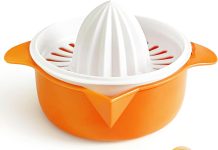Imagine trying to extract the refreshing, sweet nectar from fruits with hard pits, like the beloved mango. As we embark on this flavorful journey, we find ourselves faced with the challenge of efficiently juicing these delectable fruits. Our article will explore various methods and share tips on how to successfully juice fruits with hard pits, like the vibrant and juicy mango. Get ready to quench your thirst and elevate your juicing game with these tried and tested techniques!
Review contents
Choosing the Right Mangoes
When it comes to preparing delicious mango juice, selecting the right mangoes is key. The first step in choosing the right mangoes is to ensure they are ripe and ready to eat. A ripe mango should emit a sweet aroma and have a slight give when gently squeezed. The color of the skin can vary depending on the variety, but it should be vibrant and free from any wrinkles or blemishes.
Selecting Ripe Mangoes
To select ripe mangoes, you can also look for certain visual cues. The fruit should have a slight softness when pressed, but it shouldn’t be too mushy. Avoid choosing mangoes that have overly wrinkled skin, as this may indicate overripeness or spoilage. Additionally, a ripe mango will have a fruity fragrance that is hard to resist.
Identifying the Best Varieties
There are numerous mango varieties available, each with its own unique flavor profile. Some popular mango varieties known for their sweetness and juiciness include Alphonso, Kent, and Keitt. These varieties are excellent choices for making mango juice. However, it ultimately comes down to personal preference, so don’t be afraid to experiment with different varieties to find the one you enjoy the most.
Preparing the Mangoes
Once you have selected the perfect mangoes, it’s time to prepare them for juicing. This process involves washing the mangoes, peeling off the skin, and removing the pit.
Washing the Mangoes
Before handling the mangoes, it’s important to wash them thoroughly to remove any residue or dirt. Simply rinse the mangoes under cool running water and use a gentle scrub brush to clean the skin. This step ensures that no external contaminants make their way into your refreshing mango juice.
Peeling the Mangoes
To peel the mangoes, start by making a small cut at the top stem end. Then, using a sharp knife, carefully slide it between the skin and the flesh, following the natural curve of the fruit. Continue peeling in a circular motion, working your way down to the bottom of the mango. Repeat this process for each mango until they are all peeled and ready to be juiced.
Removing the Pit
To remove the pit, hold the peeled mango in one hand and use a spoon to gently scoop out the flesh around the pit. Be cautious and avoid applying too much pressure to prevent damaging the fruit. Alternatively, you can use a specialized mango cutter tool to neatly remove the pit.
Juicing Methods
There are two main methods for juicing mangoes: blending and extracting. Both methods have their advantages, so it’s up to you to choose the one that best suits your preferences and equipment availability.
Blending Method
The blending method involves using a blender to puree the mango flesh and extract the juice. This method is convenient and accessible as most households have blenders readily available.
Using a Blender
To use a blender for juicing mangoes, simply place the peeled and pitted mango pieces into the blender jug. Blend on high speed until the mango flesh is fully pureed and the juice is smooth. The result will be a creamy and pulpy mango juice.
Straining the Juice
If you prefer a smoother and pulp-free juice, you can strain the blended mango juice through a fine-mesh sieve or cheesecloth. Straining will remove any larger pulp or fibers, resulting in a silky smooth mango juice.
Extracting Method
The extracting method involves using a juicer specifically designed to extract juice from fruits and vegetables. This method is ideal for those who want a clear and pulp-free mango juice.
Using a Juicer
To juice mangoes using a juicer, cut the peeled and pitted mango into small pieces that will fit through the feed tube of the juicer. Turn on the juicer and feed the mango pieces through the machine. The juicer will separate the juice from the pulp, resulting in a clear and vibrant mango juice.
Straining the Juice
Even though juicers extract a clear juice, some pulp may still make its way into the final product. If you prefer a completely pulp-free juice, strain the juice extracted from the juicer through a fine-mesh sieve or cheesecloth to achieve a smooth consistency.
Enhancing the Flavor
While mango juice on its own is incredibly delicious, you can enhance its flavor by adding other ingredients such as citrus fruits, herbs, or spices.
Adding Citrus Fruits
Adding a squeeze of lemon or lime juice to your mango juice can brighten the flavors and add a refreshing tang. Simply squeeze the juice of a lemon or lime into your mango juice and stir gently to incorporate the flavors.
Incorporating Herbs or Spices
To add a unique twist to your mango juice, you can experiment with incorporating herbs or spices. Mint leaves or basil can impart a refreshing herbal essence, while a dash of cinnamon or a sprinkle of cardamom can add warm and aromatic notes to your mango juice. Be adventurous and try different combinations until you find your perfect flavor profile.
Serving and Storing
After preparing and enhancing your mango juice, it’s time to serve and store it properly to maintain its freshness and flavor.
Pouring the Juice
When pouring your mango juice, use a pitcher or a jug with a spout to make serving easier. Take care not to spill or splash the juice, as mango juice can leave stains on clothing and surfaces.
Serving Suggestions
Mango juice can be enjoyed on its own as a refreshing beverage, but it can also be used in various culinary creations. You can use it as a base for smoothies, popsicles, cocktails, or even as a dressing for salads. Get creative with how you incorporate mango juice into your meals and beverages.
Storing the Juice
If you have any leftover mango juice, store it in an airtight container or bottles in the refrigerator. Properly stored, mango juice can last for up to three days. Before consuming the stored juice, give it a quick shake to redistribute any natural pulp or sediment that may settle.
Tips and Tricks
To make the most out of your mango juice preparation, here are some useful tips and tricks to keep in mind.
Mango Ripening Tips
If your mangoes are not ripe enough, you can speed up the ripening process by placing them in a brown paper bag at room temperature. Adding an ethylene-producing fruit like a banana or apple to the bag can further accelerate ripening.
Optimal Juice Consistency
The consistency of your mango juice is entirely up to personal preference. If you prefer a thicker and more substantial juice, use a blender and skip the straining process. On the other hand, if you like a smoother and pulp-free juice, strain the juice after blending or juicing.
Creative Mango Juice Recipes
While mango juice is delicious on its own, you can unleash your creativity by incorporating other fruits or flavors. Create a tropical blend by adding pineapple or coconut, or create a zesty twist with a splash of orange juice. The possibilities are endless, so don’t be afraid to experiment and invent your own mango juice recipes.
Health Benefits of Mango Juice
In addition to being a tasty treat, mango juice offers several health benefits. Here are some reasons why mango juice should be a part of your diet.
Rich Source of Vitamins
Mango juice is packed with essential vitamins, including vitamin C, vitamin A, and vitamin E. These vitamins play a vital role in supporting overall health, boosting the immune system, and promoting healthy skin.
Boosts Immunity
The high vitamin C content in mango juice helps strengthen the immune system, protecting the body against illnesses and infections. Regularly consuming mango juice can contribute to a stronger immune system and better overall health.
Improves Digestion
Mango juice contains dietary fiber, which aids in proper digestion and prevents constipation. It also contains natural enzymes that help break down proteins in the body, making it easier for your digestive system to process and absorb nutrients.
Conclusion
Whether you choose to blend or extract your mango juice, there are numerous ways to prepare and enjoy this tropical treat. The process may seem daunting at first, but with the right mangoes and a few simple steps, you can savor the fresh and delightful taste of homemade mango juice. Don’t forget to add some citrus fruits or experiment with herbs and spices to enhance the flavor. Take advantage of the health benefits mango juice offers, such as boosting immunity and improving digestion. So, go ahead and indulge in this luscious, thirst-quenching beverage that captures the essence of summer in every sip. Cheers to delicious mango juice!


































